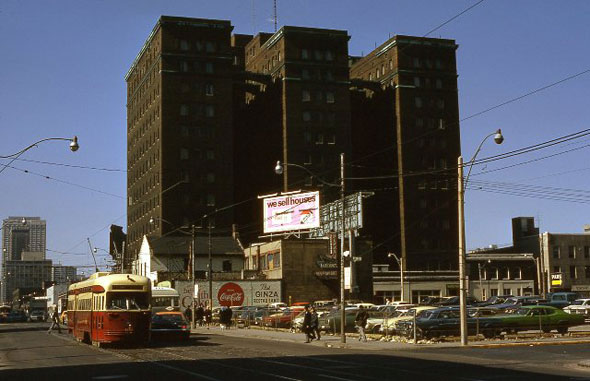
In the early 1920s, R.T. Ford & Company was busily building near-identical hotel buildings in the state of New York and here in Ontario. The company's founder and president Richard T. Ford clearly believed in his business model: he named the luxury chain and every hotel in his empire after himself.
In Toronto, the Ford Hotel was finished in 1929, a year before the Royal York, on the northeast corner of Bay and Dundas at a cost of $2 million, including land. Its location on the site of a former church next to the open-air bus terminal made it extremely convenient for inbound visitors to the city. Unfortunately, the owners' dedication to low prices didn't translate into a glamourous reputation.
When it was eventually demolished in 1973, The Star rightly crowned it the "Queen of Dumps." Its story might be sleazy and blighted by horrific violence and terrible sadness but the history of the Ford Hotel is anything but boring.
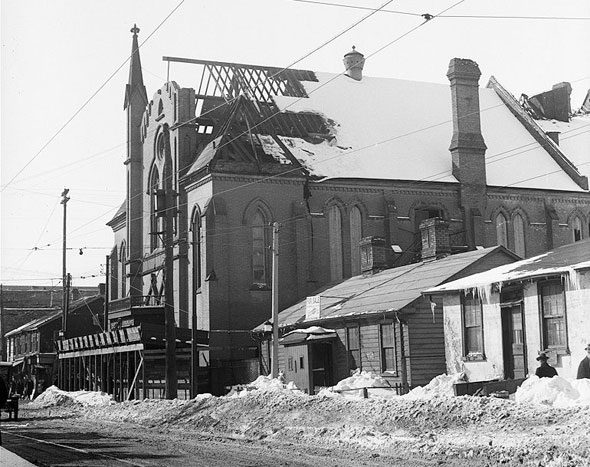
When the Old National Theater was gutted by fire in the winter of 1924, the former Agnus St. Church building it was housed inside gave up a 51-year-old secret. A copy of The Globe, tucked inside the cornerstone of the building, dryly discussed economic news from England and the benefits of a new municipal waterworks. The building that would replace the church would make headlines for entirely different reasons.
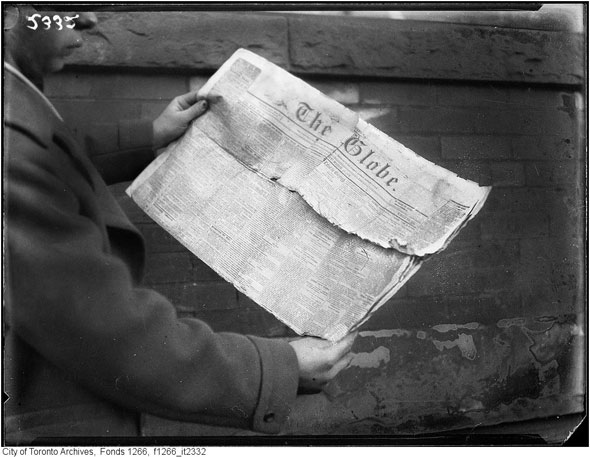
In 1928, the 12-storey Ford Hotel became the latest in an expanding empire of near-identical buildings popping up in the Lake Ontario and Erie region. The chain was headquartered in Rochester, NY.
James Suydam, a director of the Toronto hotel, hoped to have a portion of the brick building open for a race weekend that was expected to draw a big out-of-town crowd. In the restaurant downstairs, Lou Scholes, champion rower and part-owner of the old Scholes Hotel on Yonge Street, feverishly prepped the kitchen and dining room. Construction also hadn't gone entirely to plan: a worker, Jack Holton, accidentally got banana oil (a common ingredient in varnishes and lacquers) in his eyes. Half blind, he had to be escorted to the hospital but was able to return to work a few days later.
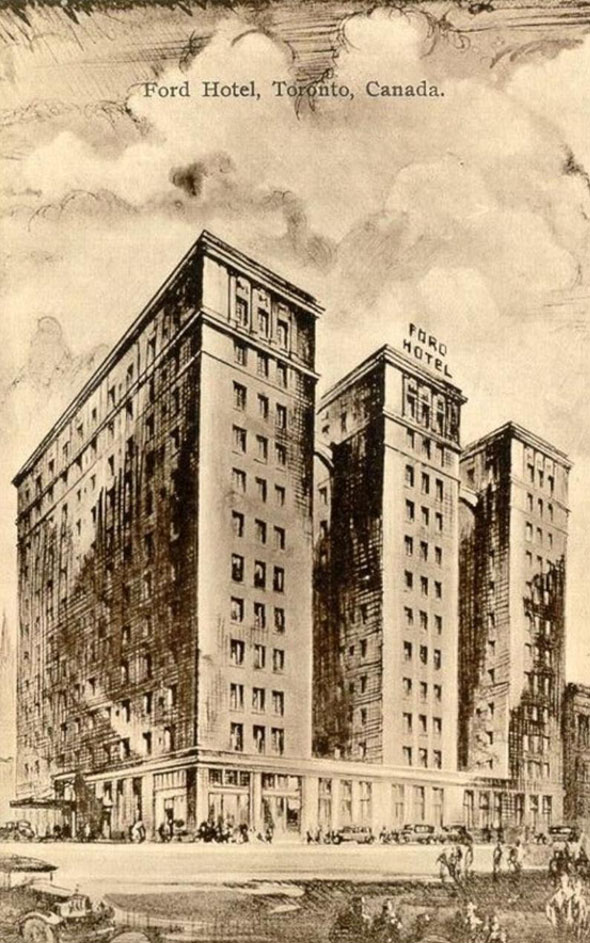 The opening reception on May 31st 1928 featured Toronto mayor Sam McBride, Ontario Premier Howard Ferguson,
a delegation of MPPs, and a group of the company's top brass from
Buffalo. McBride was given a golden key that he used to ceremonially
unlock the hotel doors and register as the first official guest.
According to The Star, "the rotunda of the hotel was profuse
with flowers, gifts of local and international hotel associations, and
private well-wishers."
The opening reception on May 31st 1928 featured Toronto mayor Sam McBride, Ontario Premier Howard Ferguson,
a delegation of MPPs, and a group of the company's top brass from
Buffalo. McBride was given a golden key that he used to ceremonially
unlock the hotel doors and register as the first official guest.
According to The Star, "the rotunda of the hotel was profuse
with flowers, gifts of local and international hotel associations, and
private well-wishers."The 500 guests ate in the main dining room and toasted the city, Buffalo, and Lou Scholes, a man still held in high regard for his victory in the prestigious Diamond Challenge Sculls at the Henley Royal Regatta in England. Scholes became the first Canadian to win the men's singles event when he beat Arthur Cloutte to victory in 1904. Cloutte would be sentenced to hard labour in 1913 for stealing from his employer, Barings Bank.
On its first day, the Ford Hotel advertised rooms for between $1.50 and $3.50 and boasted a valet, barber, cigar store, newsstand, public stenographer, and laundry service. Guests had access to circulating iced water and reading lamps. The beds, apparently, induced "vigor, ambition, and charm." It wouldn't last.
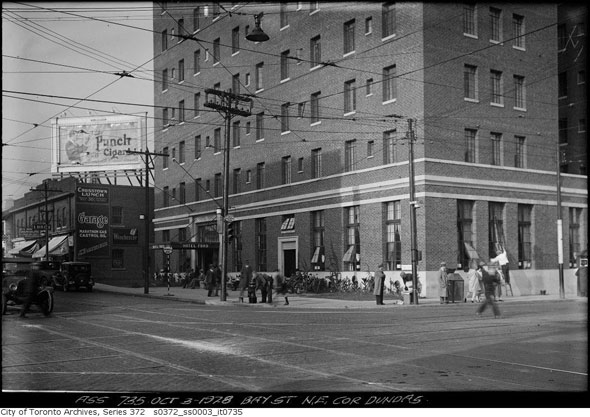 Down on Front Street, the Royal York hotel
was opened on the site of the old Queen's Hotel - a former employer of
manager Scholes - in 1929 and immediately snatched the title of
Toronto's most luxurious hotel from the Ford. Despite the competition,
the hotel at Bay and Dundas continued to peddle affordable splendor.
Down on Front Street, the Royal York hotel
was opened on the site of the old Queen's Hotel - a former employer of
manager Scholes - in 1929 and immediately snatched the title of
Toronto's most luxurious hotel from the Ford. Despite the competition,
the hotel at Bay and Dundas continued to peddle affordable splendor.All manner of dances, dinners and galas were held in the restaurant space in the lower levels. Ironically, one of the early conventions was put on by Seventh Day Adventists who railed against modern evils to a group of young women. "Young people were urged to eschew erotic literature and to shun the evils of stage, film, and dancehall," according to newspaper reports.
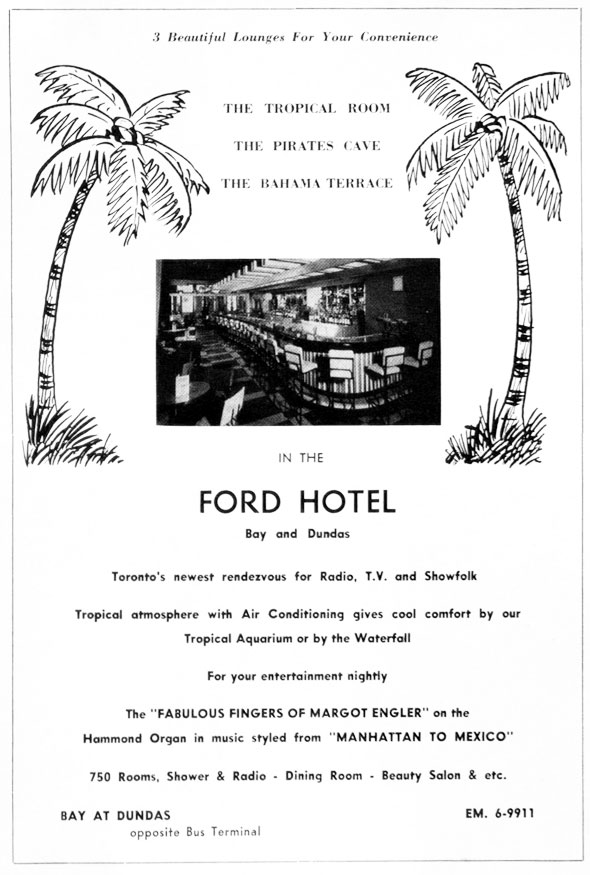 In
what appears to be the first in a series of tragic events, a
30-year-old Montreal woman, "Mrs. Richie," dressed in a red dress, fur
hat, and fawn coloured coat, requested a room with a view at the Ford.
Once inside, at 11:40 am precisely, she pushed a chair against the
window, opened it wide, and jumped to her death onto the roof of the
second-floor restaurant. Her fair hair was gently blowing in the late
summer breeze when police reached her lifeless body minutes later.
In
what appears to be the first in a series of tragic events, a
30-year-old Montreal woman, "Mrs. Richie," dressed in a red dress, fur
hat, and fawn coloured coat, requested a room with a view at the Ford.
Once inside, at 11:40 am precisely, she pushed a chair against the
window, opened it wide, and jumped to her death onto the roof of the
second-floor restaurant. Her fair hair was gently blowing in the late
summer breeze when police reached her lifeless body minutes later.The Ford's decent into seediness was gradual. Attempts at reworking the venue into a swinging performance venue were optimistic but never gained traction. Various themed rooms, hopelessly tacky by today's standards, and a reworking of the existing bar were in place when it was taken over by group from New York in 1954.
 In
1955, all hell broke lose. Zarano Borg, an itinerant Maltese laborer,
checked into the Ford Hotel claiming he wanted to be closer to the
hustle and bustle of the city. His old place on Broadview Avenue was too
quiet.
In
1955, all hell broke lose. Zarano Borg, an itinerant Maltese laborer,
checked into the Ford Hotel claiming he wanted to be closer to the
hustle and bustle of the city. His old place on Broadview Avenue was too
quiet.Clearly unstable, Borg paced the hotel wrapped in a bedsheet until management ordered him back to his room. In the confined space, Borg became increasingly agitated and distressed. Then things took a nasty turn. The laborer pulled a 12-gauge shotgun from his suitcase and began firing shots into the walls. The night manager, who believed Borg had firecrackers, had to jump out of the way when the door to the room exploded into splinters as he arrived to investigate.
Police quickly commandeered a nearby room, which, thanks to the design of the hotel, had a window facing Borg's. In a moment, after a brief scare, cops tossed a tear gas capsule inside the room to temporarily blind the crazed man. When the gas cleared and Borg appeared to be still, police ventured inside to find his lifeless body slumped on the bed. He had shot himself.
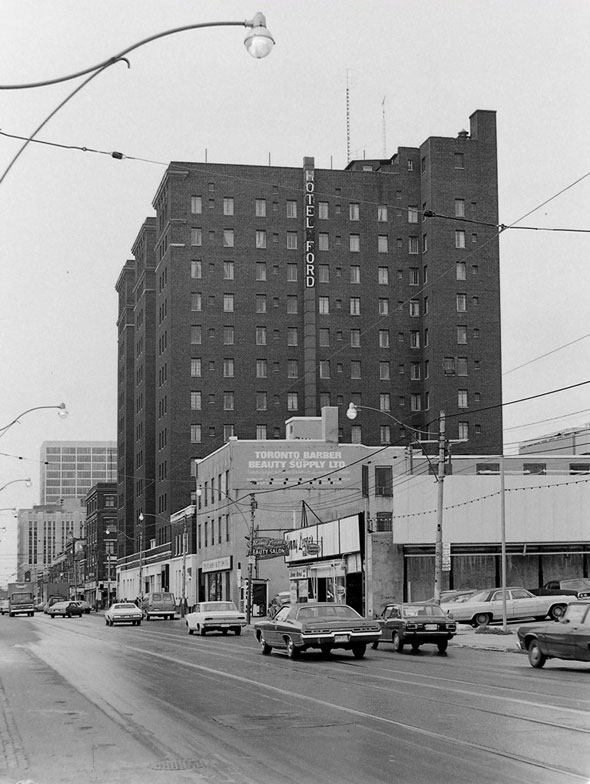 Despite minor renovations during its brief spell in the Sheraton
chain, the Ford Toronto was increasingly dilapidated in its final
decades. Not only were some of the old fixtures defective, one would
prove deadly.
Despite minor renovations during its brief spell in the Sheraton
chain, the Ford Toronto was increasingly dilapidated in its final
decades. Not only were some of the old fixtures defective, one would
prove deadly.A serious fire killed one man, Edwin Paterson, and injured three others on the seventh floor in 1969. Paterson, a 77-year-old resident of the hotel, died from his injuries in the fire which started in the room of another elderly resident, C. H. Villiers. The damage to the building was around $16,000.
The next year, Mohammad Ashraf, a 34-year-old engineer recently arrived from Pakistan, left his 12th floor room to explore the city and called an elevator. When the doors opened, Ashraf, without thinking, stepped through. He fell to his death down the empty lift shaft and crashed through the roof of the car, which was still at the lobby.
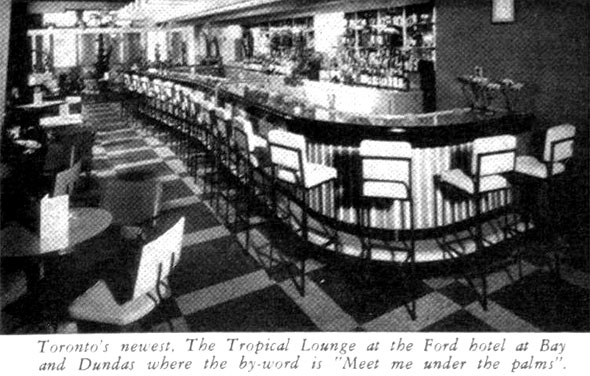 The
final chapter in the Ford Hotel's history was similarly tragic. On July
26th, 1973 the lifeless, mutilated body of 9-year-old Kirkland Deasley
was found on the bed of a ninth floor room by Nabir Cassir, a clerk.
Deasley had left home that day to earn money carrying groceries at a
Parliament Street supermarket and had seemingly been lured inside by a
man later identified as John McBeth Finlayson, a 37-year-old drifter and
part-time baker. He had been sexually assaulted, bitten, and strangled.
The
final chapter in the Ford Hotel's history was similarly tragic. On July
26th, 1973 the lifeless, mutilated body of 9-year-old Kirkland Deasley
was found on the bed of a ninth floor room by Nabir Cassir, a clerk.
Deasley had left home that day to earn money carrying groceries at a
Parliament Street supermarket and had seemingly been lured inside by a
man later identified as John McBeth Finlayson, a 37-year-old drifter and
part-time baker. He had been sexually assaulted, bitten, and strangled.As police released details of the shocking crime, vigilante groups began roaming the east end where men matching Finlayson's description had been seen. Meanwhile, Cassir, the clerk who made the gruesome discovery, received threatening calls telling him to keep quiet about the crime. He said an anonymous caller to the hotel has asked room 955 to be locked prior to the child's body being found. Kirk Deasley was buried in his baseball uniform along with his catching glove, ball, and prized hockey trophy on July 31, 1973.
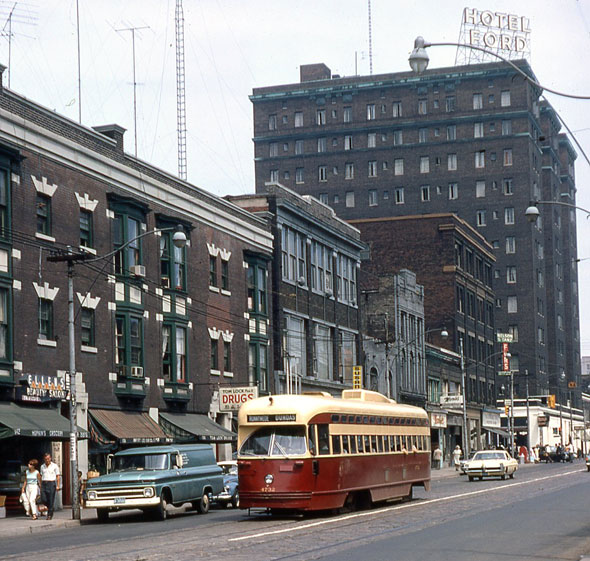 The
day before, a man wearing blue workpants and shirt was spotted walking
along a highway feeder road west of Burlington, his thumb out for a
ride. A suspicious driver called phoned in a report and that afternoon
cops picked up the wanted man and returned him to Toronto.
The
day before, a man wearing blue workpants and shirt was spotted walking
along a highway feeder road west of Burlington, his thumb out for a
ride. A suspicious driver called phoned in a report and that afternoon
cops picked up the wanted man and returned him to Toronto.At his trial, John McBeth Finlayson pleaded not guilty but admitted he was responsible for the death of Deasley. The court heard how Finlayson attacked his sisters as a child and would watch them dress. In separate incidents, the troubled man attempted to throttle his older sister and bludgeon his younger sibling with a wrench. His family life was defined by fights, alcohol abuse, and screaming matches.
As an adult, he would regularly beat his wife and spend several months in the Don Jail for attacking the four-year-old son of a friend. In 1969, he lured two young girls to his apartment on Parkwoods Village Drive. He was sentenced to Millbrook Correctional Centre but later moved to a facility for alcoholics and sexual deviants. A 12-person jury found Finlayson not guilty by reason of insanity and he was admitted to a high-security psychiatric hospital.
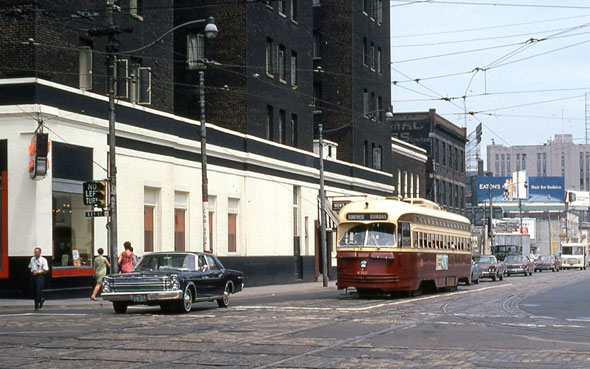 The
case likely finished off the Ford Hotel's reputation. The business
announced it would close in 1973 and workers would soon begin
demolishing the building. Bar and bedroom furniture, TVs, pictures, and
furnishings were snapped up by nostalgia buffs. Various grubby signs,
bottles of bear oil, and even a barber's chair were hot ticket items at
the sale.
The
case likely finished off the Ford Hotel's reputation. The business
announced it would close in 1973 and workers would soon begin
demolishing the building. Bar and bedroom furniture, TVs, pictures, and
furnishings were snapped up by nostalgia buffs. Various grubby signs,
bottles of bear oil, and even a barber's chair were hot ticket items at
the sale.Various papers eulogized the hotel but none seemed to believe it would be missed. "The Big F," as it had came to be known, was "a haven for prostitutes and homosexuals, a place for one-night stands, a hideout for cheating wives and husbands," according to The Star. A few indignant former customers sent letters to the editor in its defense, but when the Ford finally came down in October 1973, no-one really cared.
Photos: City of Toronto Archives, Wikimedia Commons, Bob Whalen, Robert Taylor, and Steve Munro
No comments:
Post a Comment